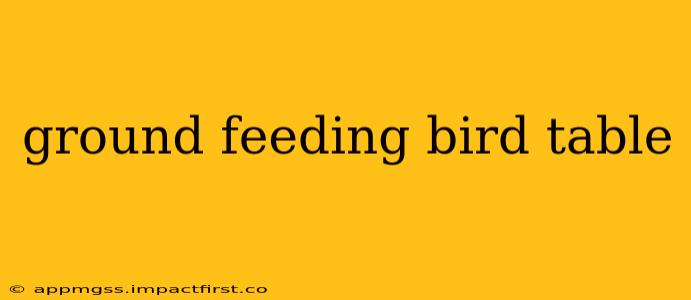Attract a wider variety of birds to your garden with a ground feeding bird table! These tables offer a different approach to bird feeding, catering to species that prefer foraging on the ground. This guide will explore the benefits, considerations, and best practices for using ground feeding bird tables, answering common questions along the way.
What are the benefits of a ground feeding bird table?
Ground feeding tables offer several advantages over traditional hanging feeders. They're particularly attractive to birds that naturally forage on the ground, such as robins, sparrows, blackbirds, and juncos. These birds often feel safer feeding at ground level, away from the threat of aerial predators like cats and hawks. A well-designed ground feeder also provides easier access for birds with mobility issues or those who are less agile at climbing. Finally, they can provide a visually engaging experience, allowing for closer observation of bird behavior.
What are the different types of ground feeding bird tables?
There's a surprising variety in ground feeding bird table designs. You'll find simple, shallow platforms, elevated platforms with legs to keep food off the ground and away from dampness, and more complex designs with covers to protect food from rain and snow. Some incorporate features like mesh or grid bottoms to prevent larger birds from dominating the food supply and to allow smaller birds better access. Others include integrated perches for those birds who prefer a mixture of perching and ground feeding.
What type of birdseed is best for a ground feeding bird table?
The best birdseed for a ground feeding bird table depends on the birds you want to attract. A good general mix often includes seeds like sunflower seeds (black oil sunflower seeds are particularly popular), nyjer seed, millet, and cracked corn. Avoid using bread or other processed foods, as they lack nutritional value and can be harmful to birds. Consider offering mealworms or suet during colder months to provide extra protein and energy.
What are the disadvantages of ground feeding?
While ground feeding offers many benefits, it also has some drawbacks. The most significant concern is the potential for attracting unwanted visitors like rodents, squirrels, and larger birds that might intimidate smaller species. Ground feeders can also be more susceptible to contamination from rain, snow, and droppings, necessitating more frequent cleaning. Finally, the food can be more vulnerable to spoilage in warmer weather.
How do I keep squirrels away from my ground feeder?
Squirrels are notorious for raiding bird feeders. To deter them from your ground feeder, consider using a feeder with a squirrel baffle or guard, which prevents them from reaching the food. Alternatively, placing the feeder in a location that makes it difficult for squirrels to access, such as beneath overhanging branches, can also be helpful. You can also try using feeders designed specifically to prevent squirrel access, such as those with weight-activated mechanisms that close when a squirrel attempts to access the food.
How often should I clean my ground feeding bird table?
Regular cleaning is essential to prevent the spread of disease and parasites. You should aim to clean your ground feeder at least once a week, removing any spilled seed, droppings, and debris. A thorough cleaning with warm soapy water should suffice. Consider using a mild disinfectant solution once a month to eliminate any harmful bacteria or parasites. Always allow the feeder to dry completely before refilling.
How do I choose the right location for my ground feeding bird table?
Selecting the right location is crucial for the success of your ground feeding bird table. Choose a spot that offers some protection from the elements – shade from direct sunlight and shelter from strong winds and rain. Ensure the area is relatively clear of tall grass or vegetation that might obscure the feeder from birds or provide cover for predators. Proximity to shrubs or trees where birds can safely perch and observe before approaching the feeder will also enhance its effectiveness.
By carefully considering these factors, you can create a thriving ground feeding station that attracts a vibrant community of birds to your garden, offering both enjoyment for you and crucial sustenance for your feathered friends.
